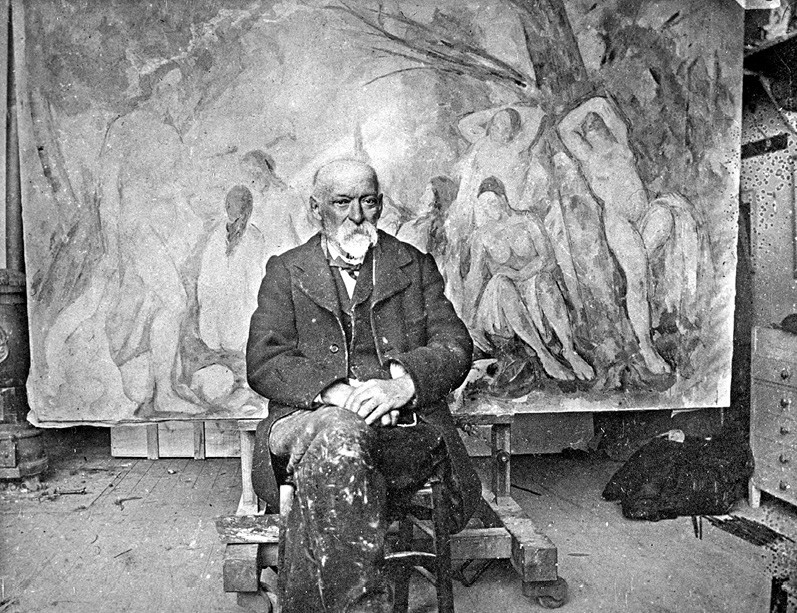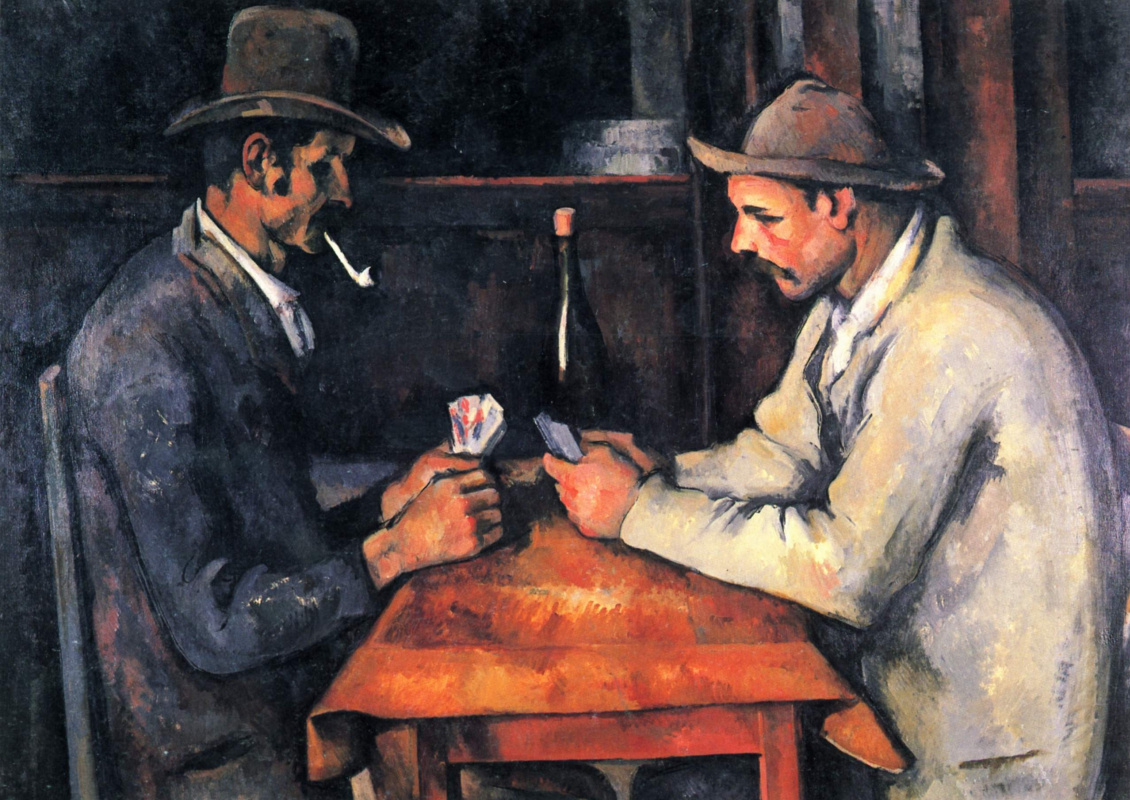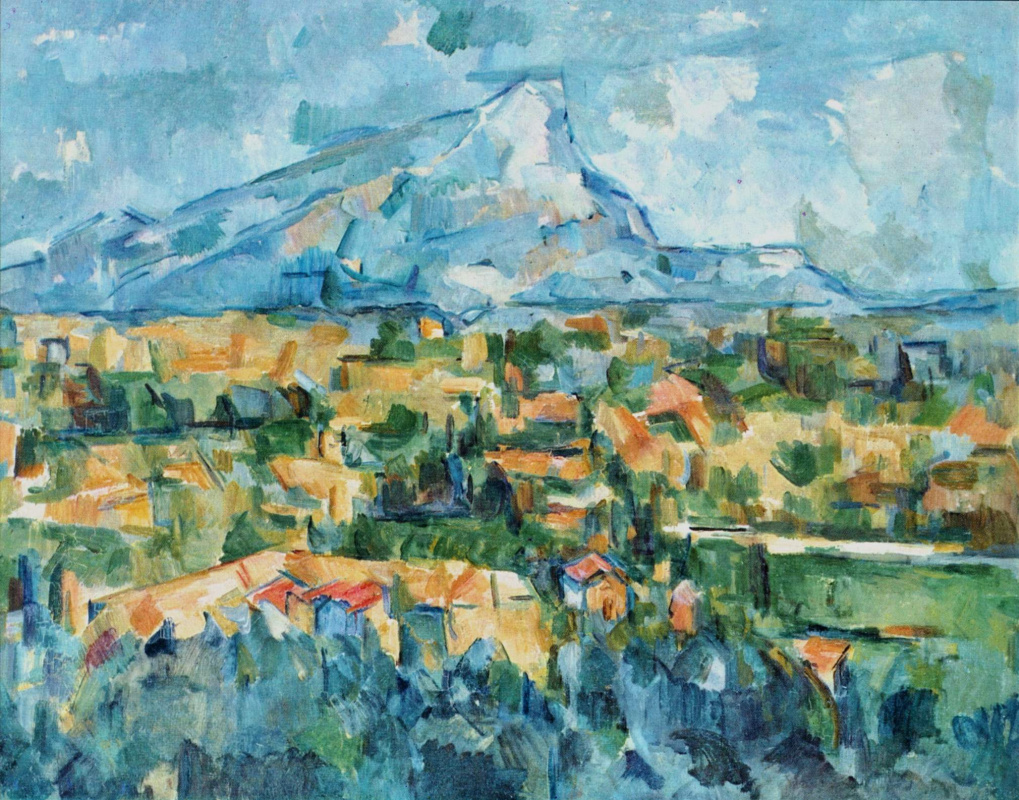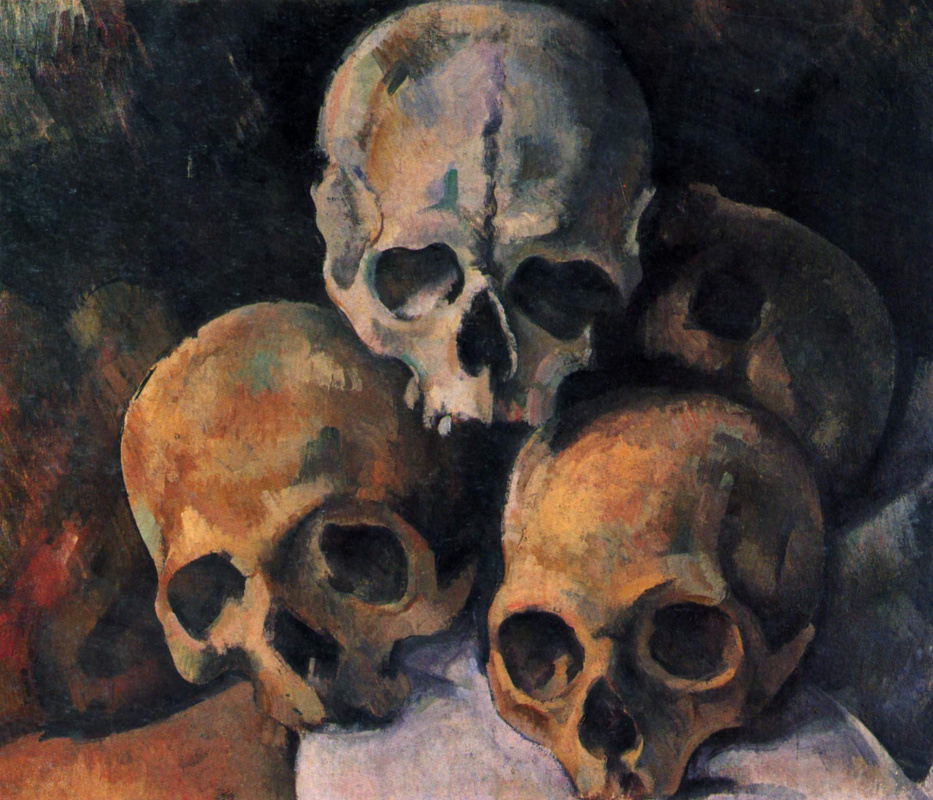Most of his life, Paul Cezanne played the role of a rough, grumbling, eccentric weirdo. In fact, he was masking his passionate, indecisive, and shy nature. Cezanne was brilliant in this role. To unravel the real Cezanne — an educated intellectual reciting Virgil, a deep philosopher with an excellent sense of humor, a wise sage — to hear some of his conversations with close friends and read a couple of letters would have been enough.

Basically, if you have character, you have talent. I don’t say that character is enough, that it’s enough to be a good fellow to paint well. That would be too easy. But I don’t believe that a scoundrel can have genius. Keep your hands clean, I mean. All artists, parbleu, more or less, always go a bit off the rails, this way or that. There are some who, in order to make it … yes, but I believe those are the very ones who don’t have talent. You have to be incorruptible in your art, and to be so in your art, you have to train yourself to be so in your life.
Talking about art is almost useless. Work which realizes some progress in one’s own craft is sufficient compensation for not being understood by imbeciles.
Only Courbet knows how to slap on a black, without making a hole in the canvas.
Talking about art is almost useless. Work which realizes some progress in one’s own craft is sufficient compensation for not being understood by imbeciles.
Only Courbet knows how to slap on a black, without making a hole in the canvas.
Each brushstroke I make is a little of my blood mixed with a little of your father’s blood, and that there’s a mysterious exchange which he isn’t aware of, which goes from his soul to my eye, which recreates it, and in which he will recognize himself… We must live in harmony, my model, my colors, and me, and together catch the same passing moment. (As Cezanne put it to Joachim Gasquet, son of Henri Gasquet)
God help them (Ed.- of ignoramuses) if they cannot imagine how you can make a mouth look sad or a cheek smile by blending a fine shade of green with a red.
Between what makes up your personality and mine, there is the world, the sun, what’s going on, what we see in common. Our clothes, our bodies, the play of light, I have to dig through all that. That’s where the slightest misplaced brushstroke spoils everything. If I’m purely emotional about it, I slap your eye on sideways. If I weave around your expression the entire network of little bits of blue and brown that are there, that combine there, I’ll get you to look as you look, on my canvas. One stroke after the other, one after the other. And if I’m unemotional, if I draw and paint as they do in the schools, I’ll no longer see anything. A mouth, a nose, by the book, always the same, with no soul, no mystery, no passion. Every time I’m at the easel I’m a different man, and always Cézanne.
Despite his style and his admirers, Ingres is only a very minor painter.
God help them (Ed.- of ignoramuses) if they cannot imagine how you can make a mouth look sad or a cheek smile by blending a fine shade of green with a red.
Between what makes up your personality and mine, there is the world, the sun, what’s going on, what we see in common. Our clothes, our bodies, the play of light, I have to dig through all that. That’s where the slightest misplaced brushstroke spoils everything. If I’m purely emotional about it, I slap your eye on sideways. If I weave around your expression the entire network of little bits of blue and brown that are there, that combine there, I’ll get you to look as you look, on my canvas. One stroke after the other, one after the other. And if I’m unemotional, if I draw and paint as they do in the schools, I’ll no longer see anything. A mouth, a nose, by the book, always the same, with no soul, no mystery, no passion. Every time I’m at the easel I’m a different man, and always Cézanne.
Despite his style and his admirers, Ingres is only a very minor painter.
The artist at work
1875, 24×34 cm
I too was an impressionist, I won’t hide it. Pissarro had an enormous influence on me. But I wanted to make of impressionism something solid and enduring like the art of museums. …But, listen, a green patch is enough to give us a landscape, just as a flesh tone translates into a face, or gives us a human figure. Which means that all of us perhaps come out of Pissarro… Already in [18]65 he had eliminated black, bitumen, sienna and the ochers [from his palette]. That’s a fact. Paint only with the three primary colors and their immediate derivatives, he told me. He was the first impressionist.
Me, I proceed very slowly, as you can tell. Nature appears to me so complicated. There are constant improvements to be made, without getting mixed up in a dream of reason.
I’d like to mix melancholy and sunshine. There’s a sadness to Provence that no one has captured, that Poussin would have got leaning on some tomb, under the poplars of Les Alyscamps. I’d like to put reason in the grass and tears in the sky, like Poussin. But you have to content yourself… You really have to see your model and sense it exactly, and then if I express myself with distinction and force, there’s my Poussin, my own classicism . There is taste. Taste is the best judge. It is rare.
I’m more traditional than people think. It’s like Rodin. No one really knows what he’s like, deep down. He’s a man of the Middle Ages who makes admirable pieces, but who doesn’t see the whole… Listen, I don’t want to be little Rodin… I like him, I admire him a great deal, but he is very much of his time, as we all are. We make pieces. We no longer know how to compose.
Me, I proceed very slowly, as you can tell. Nature appears to me so complicated. There are constant improvements to be made, without getting mixed up in a dream of reason.
I’d like to mix melancholy and sunshine. There’s a sadness to Provence that no one has captured, that Poussin would have got leaning on some tomb, under the poplars of Les Alyscamps. I’d like to put reason in the grass and tears in the sky, like Poussin. But you have to content yourself… You really have to see your model and sense it exactly, and then if I express myself with distinction and force, there’s my Poussin, my own classicism . There is taste. Taste is the best judge. It is rare.
I’m more traditional than people think. It’s like Rodin. No one really knows what he’s like, deep down. He’s a man of the Middle Ages who makes admirable pieces, but who doesn’t see the whole… Listen, I don’t want to be little Rodin… I like him, I admire him a great deal, but he is very much of his time, as we all are. We make pieces. We no longer know how to compose.
Today everything is changing, but not for me. I live in the town of my boyhood, and I rediscover the past in the faces of the people of my own age. What I like most of all is the look of people who have grown old without drastically changing their habits, who obey the rules of time; I deplore the efforts of those who try to insulate themselves from that process.
The Louvre is the book where we learn to read," he instructed Bernard. "However, we should not be content to rest on the beautiful formulas of our illustrious predecessors. Let us go out to study beautiful nature, let us try to capture its spirit, let us try to express ourselves according to our individual temperament.
All my compatriots are arseholes beside me.
Today our sight is a little tired, abused by the memory of a thousand images. And the museums, and the paintings in the museums! And the exhibitions! We no longer see nature; we see paintings, over and over again. To see the work of God! That’s what I apply myself to. But am I what they call a realist or an idealist, or just a painter, a draftsman? I’m afraid of being compromised, my situation is very serious; nevertheless I’m a recognized painter, aren’t I?
The Louvre is the book where we learn to read," he instructed Bernard. "However, we should not be content to rest on the beautiful formulas of our illustrious predecessors. Let us go out to study beautiful nature, let us try to capture its spirit, let us try to express ourselves according to our individual temperament.
All my compatriots are arseholes beside me.
Today our sight is a little tired, abused by the memory of a thousand images. And the museums, and the paintings in the museums! And the exhibitions! We no longer see nature; we see paintings, over and over again. To see the work of God! That’s what I apply myself to. But am I what they call a realist or an idealist, or just a painter, a draftsman? I’m afraid of being compromised, my situation is very serious; nevertheless I’m a recognized painter, aren’t I?
The main thing in a painting is finding the right distance.
All my life, I have worked to be able to earn my living, but I thought that one could do good painting without attracting attention to one’s private life. Certainly an artist wishes to improve himself intellectually as much as possible, but the man should remain obscure. The pleasure must be found in the study .
Unlike Monet, Renoir doesn’t have a consistent aesthetic; his genius makes it difficult for him to find a way of working. Monet sticks to a single vision of things; he gets where he’s going and stays there. Yes, a man like Monet is fortunate; he reaches his beautiful destiny.
Institutes, pensions, and honors are only for cretins, jokers, and rascals.
I look for the light—the cylinder and the sphere; I want to make black and white with color, to recapture the confusion of sensations. La sensation above all.
For the painter, pride is everything. You have to have pride and not let it show too much, you have to be decent. But Gauguin had too much, he amazed me. Ah! Renoir? He’s too stiff.
I am a milestone, others will come who… At my age, you dream of eternity.
There’s such a strong pull, it’s painful tearing them away…My wife tells me they pop out of my head, all bloodshot… When I get up from the painting, I feel a kind of giddiness, an ecstasy, as if I were stumbling around in a fog.
All my life, I have worked to be able to earn my living, but I thought that one could do good painting without attracting attention to one’s private life. Certainly an artist wishes to improve himself intellectually as much as possible, but the man should remain obscure. The pleasure must be found in the study .
Unlike Monet, Renoir doesn’t have a consistent aesthetic; his genius makes it difficult for him to find a way of working. Monet sticks to a single vision of things; he gets where he’s going and stays there. Yes, a man like Monet is fortunate; he reaches his beautiful destiny.
Institutes, pensions, and honors are only for cretins, jokers, and rascals.
I look for the light—the cylinder and the sphere; I want to make black and white with color, to recapture the confusion of sensations. La sensation above all.
For the painter, pride is everything. You have to have pride and not let it show too much, you have to be decent. But Gauguin had too much, he amazed me. Ah! Renoir? He’s too stiff.
I am a milestone, others will come who… At my age, you dream of eternity.
There’s such a strong pull, it’s painful tearing them away…My wife tells me they pop out of my head, all bloodshot… When I get up from the painting, I feel a kind of giddiness, an ecstasy, as if I were stumbling around in a fog.
To the question "What, according to you, is the ideal of earthly happiness?" Cézanne responded: "To have a beautiful formula."
Still life with skulls
1900-th
, 39×46 cm
All that we see dissipates and disappears, does it not? Nature is always the same, but nothing remains of what we see of it. It is our art that must convey the sense of permanence, capture the elements in all their changing forms. It should give us a taste of the eternal. What lies beneath? Perhaps nothing. Perhaps everything. Everything, you understand?
One minute in the life of the world is going by. Paint it as it is!
Within the painter, there are two things: the eye and the mind; they must serve each other. The artist must work at developing them mutually: the eye for the vision of nature and the mind for the logic of organized sensations, which provide the means of expression.
I like muscles, beautiful tones, blood. I’m with Taine, and what’s more, I’m a painter. I’m a sensualist… You don’t paint souls. You paint bodies; and when the bodies are well-painted, dammit, the soul—if they have one—the soul shines through all over the place.
Within the painter, there are two things: the eye and the mind; they must serve each other. The artist must work at developing them mutually: the eye for the vision of nature and the mind for the logic of organized sensations, which provide the means of expression.
I like muscles, beautiful tones, blood. I’m with Taine, and what’s more, I’m a painter. I’m a sensualist… You don’t paint souls. You paint bodies; and when the bodies are well-painted, dammit, the soul—if they have one—the soul shines through all over the place.
Quotes are cited from the book "Cezanne: A Life" by Alex Danchev.
Title illustration: Cezanne in his studio in front of "Large Bathers", photograph by Emile Bernard.
Quotes selected and illustrated by Anna Sidelnikova
Title illustration: Cezanne in his studio in front of "Large Bathers", photograph by Emile Bernard.
Quotes selected and illustrated by Anna Sidelnikova






























